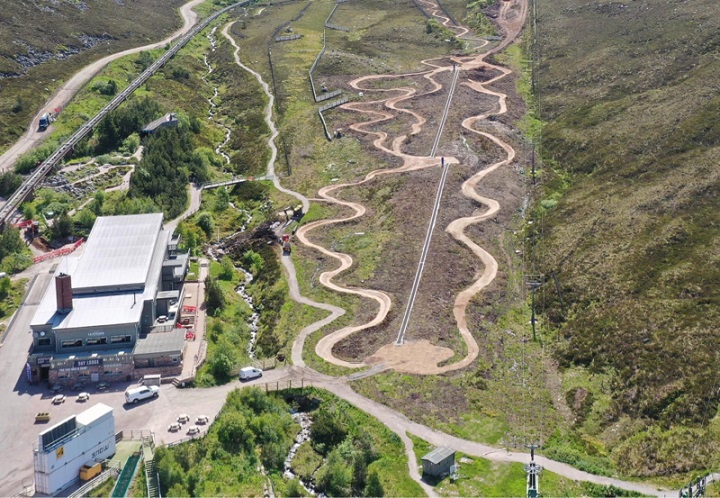
Some people might at first sight find the new mountain bike tracks running down the lower part of Coire Cas attractive. Certainly Cairngorm Mountain Scotland must have thought so when they posted this aerial photo on their Facebook Page. In landscape terms and from the air the sinuous curves of the tracks certainly look better than the rectangular forms of the Day Lodge and snow factory.
Whatever you think, the photo also tells a story about HIE’s ongoing botched management of Cairn Gorm and the failure of the planning system in the Cairngorms National Park to do anything significant to change that.
The sabotage of downhill snowsports and abuse of public funds at Cairn Gorm

HIE responded to the failure of the funicular by creating beginner’s ski area at the bottom of Coire Cas near the Day Lodge. They described this and the purchase of a factory to create artificial snow at great expense as essential. After the first season’s operation they then submitted a planning application to “smooth” the beginner’s ski area which, they argued, was necessary to make better use of the artificial snow.
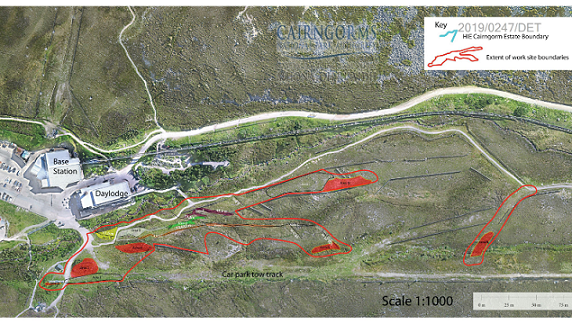
Both Graham Garfoot and I wrote a number of posts about this and Graham took the trouble (see here) to map out the area of land that would be affected. This was significantly more than HIE had claimed. Comparing the map above to the aerial photo it is clear there is an extensive overlap between the area included in the slope smoothing application and that covered by the mountain bike tracks. I aised this in a post on the magic carpet planning application last December (see here).
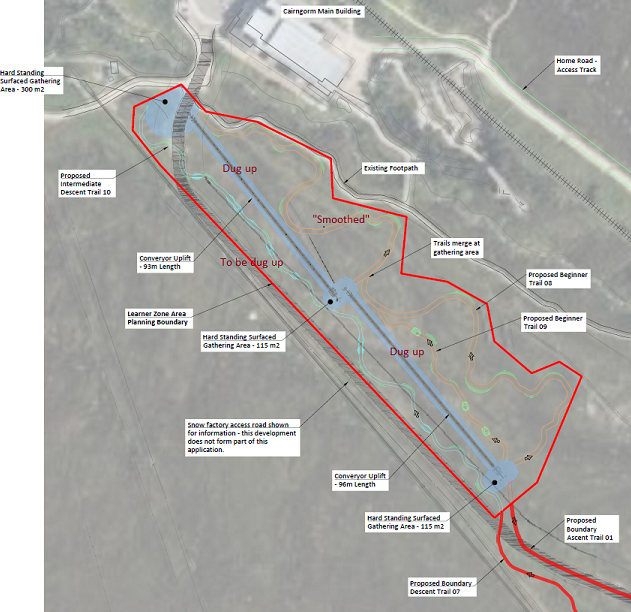
Annotated plans are one thing but photos showing what is happening on the ground, like the drone shot, often illustrate the issues much more effectively. So how is the creation of the berms, which are so visible in the aerial photo, compatible with the beginner’s snowsport area or the use of the magic carpets by skiers and boarders?
Asked this question at a recent meeting of the Association of Scottish Ski Areas, I am informed that Cairngorm Mountain Ltd (CML)’s operations manager apparently replied to the effect that CML would remove the top 1m of the berms for winter!
That certainly wasn’t in the planning application but then, as I pointed out when the application for the magic carpets was first submitted (see here):
“there is no clear explanation of how the tracks will fit with existing snowsports infrastructure and the implications for this (indeed the primary purpose of the conveyor belt in the “learning zone” would appear to be for snowsports but there is no reference to that in the application);”
It now appears that I may have got the bit in brackets wrong and that having spent a significant amount of money creating a beginners ski area, HIE changed their mind and decided to create a beginners mountain bike area instead. That would fit with CML’s separate planning application to move the snow factory up the hill.
That application (see here) included proposals to create yet another hill road at Cairn Gorm, this one alongside the car park ski tow:
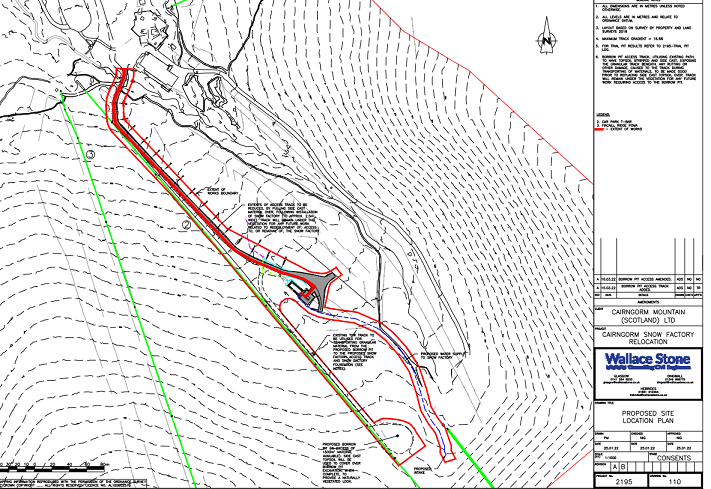
Comparing this plan to the aerial photo above, it doesn’t look like there is now room for HIE/CML to build that new hill road between the Car Park tow and the mountain bike track on the right. Are they now going to dig up the mountain bike track at the end of the season to install an access road? Or have they abandoned plans to move the snow factory? If so, what future do they now envisage for snowsports at Cairn Gorm?
Whatever the explanation HIE and their subsidiary, CML, has and is wasting shed loads of public money. The people who have benefited from this are the endless consultants and CML’s preferred contractors at Cairn Gorm, McGowan. HIE and CML should be reminded of John Maynard Keynes’ saying from the “General Theory of Employment, Interest and Money”:
“To dig holes in the ground,” paid for out of savings [Ed for which read “HIE’s bountiful funds”], will increase, not only employment, but the real national dividend of useful goods and services. It is not reasonable, however, that a sensible community should be content to remain dependent on such fortuitous and often wasteful mitigations”
The landscape impact and environmental destruction
The aerial photo shows the contrast between the ground engineered by HIE, which is almost bare, and the vegetation along the banks of the burn, which is more like how Coire Cas would look like if left to nature. While there were extensive ground works in Coire Cas in the past to construct the lifts and create pistes, the combination of ground smoothing for the beginner’s ski area and the creation of the mountain bike tracks have destroyed most of the remaining areas of undisturbed ground. CML’s webcam today provides an illustration for what has happened to the ground above what is shown in the aerial photo;

In 2016 HIE/Natural Retreats created a beginner’s ski area below the shieling which resulted in much of the land to the left of the funicular being modified (McGowan was the contractor). The construction track was left in place and subsequently granted retrospective planning permission by the CNPA. Now the construction of the bike trails means a significant area of the land to the left has also been engineered (CML had made various attempts to drain this area previously).
Each time there is ground work, it alters the hydrology of Coire Cas. The potential consequences of this have been ignored by HIE and discounted by the Public Authorities that should be responsible for this (SEPA, the Cairngorms National Park Authority and NatureScot). The basic issue is what happens when there is an extreme rain event, such as has happened at Cairn Gorm in the past and is now more likely because of the changing climate and global warming. Combine changes in the way water permeates and flows down Coire Cas, both above ground and below the surface, with the extensive bare areas shown by the aerial photo and the potential for a disaster appears very high.
The precautionary principle, the one which says conservation should come before development if the two conflict, is nowhere to be seen at Cairn Gorm. While the bare areas around the new mountain biking infrastructure will re-vegetate in the medium term, if the surface soil not washed away, the tracks themselves have had a significant impact on the landscape and will do as long as they remain in place:
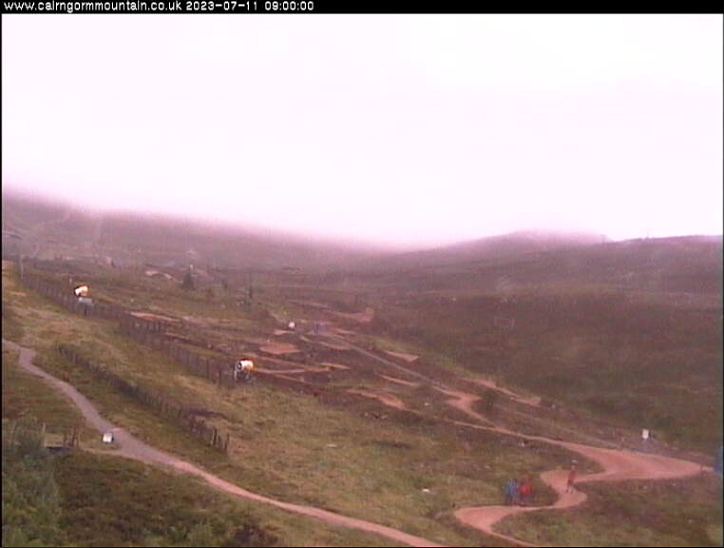
Mountain bike tracks would have been far less visible in Coire na Ciste or lower down in the forest where they would have been out of view and sheltered from the weather but the absence of any effective planning at Cairn Gorm meant this never happened.
Meantime HIE’s claim in the planning application it would plant trees to help conceal the tracks is a joke: the trees would already be there if it hadn’t been digging up the ground and driving machinery all over it on such a regular basis. Given HIE’s record the chances are that any trees they plant will be destroyed by some new planning application before they have reached any height.
The planning failures in Coire Cas
The planning system, as operated by the Cairngorms National Park Authority, has managed to approve in a short space of time a number of contradictory and conflicting planning applications for Coire Cas:
- the creation of a beginner’s snowsports area below the Shieling and then the smoothed beginners area by the Day Lodge (without any explanation of how the two might fit)?
- the creation of a mountain bike trail with berms on ground which two years previously which two years previously it has agreed should be smoothed for beginners?
- the creation of a further new road to move the snow factory up the hill when the construction tracks for the magic carpet could have also been used to transport the snow factory up the hill
The explanation for this lies in a planning system which considers applications in isolation not as a whole and treats every planning application as having “merit” whatever the context.
After a spate of planning applications at Cairn Gorm a few years ago the CNPA Board rightly pushed for HIE to produce a masterplan which they eventually agreed to do after considerable delay (see here).
What was eventually produced, however, was not a planning document but a damp squib. It was full of vague aspirations but no concrete plans which would have shown, for example, how mountain biking and ski infrastructure might fit together and their overall impact on the mountain environment. Unfortunately, instead of then demanding a proper master plan which showed how space at Cairn Gorm would be used, the CNPA Board let HIE get away with zoning the lower part of Coire Cas as an “activity area”. This has allowed HIE to chop and change their plans at will.
What now?
The evidence on the ground indicates that HIE has no credible plans for the future of snowsports at Cairn Gorm. If it hopes mountain biking will replace snowsports, the magic carpet uplift and trails are unlikely to be a success. The raindrops on the webcams and the forecast tell one that not many families will be out using them today or on the many other days of the year when its windy and wet. If the berms are removed in the periods before and after winter, as is apparently being suggested, even fewer will use them.
Set aside the environmental and landscape considerations, HIE/CML is lurching from one financial crisis. After any initial jump in visitors attracted to the refurbished Ptarmigan restaurant or the mountain bike tracks, most people will vote with their wheels, skis or feet as the attractions on offer are not fit for purpose or the environment at Cairn Gorm.
What will it take to persuade the Scottish Government that HIE are totally unfit to own or manage Cairn Gorm and that a proper plan is required for its future?
Postscript
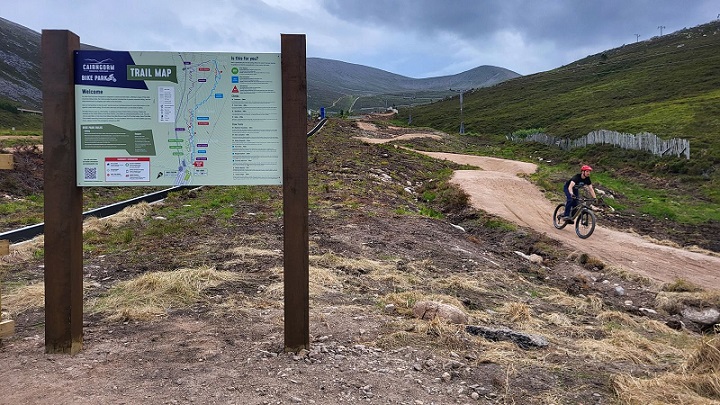
After publishing this post I was sent a link to an article on Sky News (see here) about the trails which gave a close up view of how the ground has been reworked. A quote at the end from Susan Smith, CEO, suggests that CML may really intend to smooth the berms each winter to make the ground suitable for beginner snowsports:
“By repurposing the conveyor uplifts and existing infrastructure, visitors can enjoy the natural mountain environment in every season.”

There was a comment on FB Rewilding Scotland about the Ring Ouzel. Apparently this area was suitable for three breeding pairs. “When this was being put in last year the population around the ski centre pretty much collapsed, think there was only one pair”. Says it all really. Where was the CNPA and RSPB? They’re going to remove the top 3m before the ski season, and then what? Rebuild it next year? If it wasn’t so serious it would be the joke of the year!
Yes, we visited in May and was appalled by the building work and especially the areas that used to hold Ring Ouzel. Time was when Snow Buntings were regular around the ski center and chance of a Ptarmigan on the slopes was possible without leaving the car parks.
Now it’s all been destroyed with no thought of birdlife. Sadly like us, never to return.
Total insanity. I have no idea how Cairngorm have gotten away with this. I am currently building mountain bike trails at one of Norways largest ski centres and to rebuild 1m of berm each time spring comes around is a crazy idea and would be a complete waste of money and resources – if true it just illustrates the utter incompetence of HIE and their unwillingness to listen to anyone with real knowledge of how this stuff works in practice.
I don’t know why anyone would bother to pay £22 (plus parking) to ride 3km of trails that are completely exposed to the weather and essentially go down through a building site. How will 3km of trail (with the longest trail being 1.2km in total) compete with places like Laggan (32km of trails) and Glenlivet (43km of trails) which you can ride for simply the cost of parking. For comparison it costs £17 for a day pass in a Norwegian ski centre with 17km of purpose built trail.
Ja visst Calum! The contrast with the Hovden facility in an area with a similar biophysical profile to the Cairngorms could not be more stark. There’s a major ding-dong going on within the Rewilding Scotland facebook site and this contribution would be most valid there too. Reciprocally, I am recommending that commentators there take a look here on parkswatch.
Lykke til
Ron Greer
‘natural mountain environment’: has this person taken leave of their senses, or simply lying? or is there some mysterious third category?
“What is the significance of St Swithin’s Day?
St. Swithin’s Day, also called St. Swithun’s Day, (July 15), a day on which, according to folklore, the weather for a subsequent period is dictated. In popular belief, if it rains on St. Swithin’s Day, it will rain for 40 days, but if it is fair, 40 days of fair weather will follow.” Well that was last Saturday and here in the North-East of England it has hardly stopped since and the Met office forecast is for it to continue until about the middle of August!! What will the mountain bike trails look like by then, and, how much of the material used to build them will have washed into the Cas burn? Is anyone from the CNPA or other statutory bodies taking any notice?